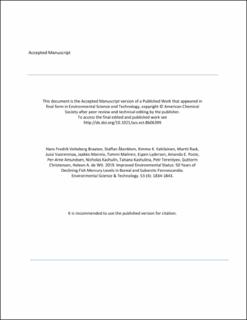| dc.contributor.author | Braaten, Hans Fredrik Veiteberg | |
| dc.contributor.author | Åkerblom, Staffan | |
| dc.contributor.author | Kahilainen, Kimmo Kalevi | |
| dc.contributor.author | Rask, Martti | |
| dc.contributor.author | Vuorenmaa, Jussi | |
| dc.contributor.author | Mannio, Jaakko | |
| dc.contributor.author | Malinen, Tommi | |
| dc.contributor.author | Lydersen, Espen | |
| dc.contributor.author | Poste, Amanda | |
| dc.contributor.author | Amundsen, Per-Arne | |
| dc.contributor.author | Kashulin, Nikolai | |
| dc.contributor.author | Kashulina, Tatiana | |
| dc.contributor.author | Terentjev, Petr | |
| dc.contributor.author | Christensen, Guttorm | |
| dc.contributor.author | de Wit, Heleen | |
| dc.date.accessioned | 2020-09-17T10:55:28Z | |
| dc.date.available | 2020-09-17T10:55:28Z | |
| dc.date.created | 2019-01-28T11:03:29Z | |
| dc.date.issued | 2019 | |
| dc.identifier.citation | Environmental Science and Technology. 2019, 53 (4), 1834-1843. | en_US |
| dc.identifier.issn | 0013-936X | |
| dc.identifier.uri | https://hdl.handle.net/11250/2678241 | |
| dc.description.abstract | Temporally (1965–2015) and spatially (55°–70°N) extensive records of total mercury (Hg) in freshwater fish showed consistent declines in boreal and subarctic Fennoscandia. The database contains 54 560 fish entries (n: pike > perch ≫ brown trout > roach ≈ Arctic charr) from 3132 lakes across Sweden, Finland, Norway, and Russian Murmansk area. 74% of the lakes did not meet the 0.5 ppm limit to protect human health. However, after 2000 only 25% of the lakes exceeded this level, indicating improved environmental status. In lakes where local pollution sources were identified, pike and perch Hg concentrations were significantly higher between 1965 and 1990 compared to values after 1995, likely an effect of implemented reduction measures. In lakes where Hg originated from long-range transboundary air pollution (LRTAP), consistent Hg declines (3–7‰ per year) were found for perch and pike in both boreal and subarctic Fennoscandia, suggesting common environmental controls. Hg in perch and pike in LRTAP lakes showed minimal declines with latitude, suggesting that drivers affected by temperature, such as growth dilution, counteracted Hg loading and food web exposure. We recommend that future fish Hg monitoring sampling design should include repeated sampling and collection of pollution history, water chemistry, fish age, and stable isotopes to enable evaluation of emission reduction policies. | en_US |
| dc.description.abstract | Improved Environmental Status: 50 Years of Declining Fish Mercury Levels in Boreal and Subarctic Fennoscandia | en_US |
| dc.language.iso | eng | en_US |
| dc.subject | atmospheric pollution | en_US |
| dc.subject | climate | en_US |
| dc.subject | Convention on Long-Range Transboundary Air Pollution | en_US |
| dc.subject | freshwater | en_US |
| dc.subject | Minamata Convention | en_US |
| dc.subject | point source pollution | en_US |
| dc.title | Improved Environmental Status: 50 Years of Declining Fish Mercury Levels in Boreal and Subarctic Fennoscandia | en_US |
| dc.type | Peer reviewed | en_US |
| dc.type | Journal article | en_US |
| dc.description.version | acceptedVersion | en_US |
| dc.subject.nsi | VDP::Landbruks- og Fiskerifag: 900::Fiskerifag: 920 | en_US |
| dc.source.pagenumber | 1834-1843 | en_US |
| dc.source.volume | 53 | en_US |
| dc.source.journal | Environmental Science and Technology | en_US |
| dc.source.issue | 4 | en_US |
| dc.identifier.doi | 10.1021/acs.est.8b06399 | |
| dc.identifier.cristin | 1666045 | |
| dc.relation.project | Norges forskningsråd: 243644 | en_US |
| cristin.unitcode | 209,2,3,0 | |
| cristin.unitname | Institutt for skog- og utmarksfag | |
| cristin.ispublished | true | |
| cristin.fulltext | postprint | |
| cristin.qualitycode | 2 | |
